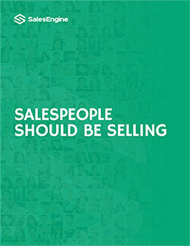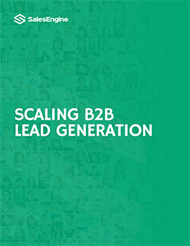Category:
Eye-Opening Statistics Changing B2B Sales
| 0
With B2B sales strategies, technologies, and best practices changing so rapidly, it’s important to find what makes your sales team successful. These 5 statistics present some valuable facts about B2B sales, and how you can begin improving your sales performance right now.
1. Sales Reps Only Spend 18% of Time Interacting with Potential Buyers (Accent)
As startling as this seems, it is common for most salespeople and SDRs to spend a big chunk of their time on data-entry and administrative tasks. The amount of time a salesperson spends selling is the number one factor in how much revenue they generate. Being saddled with administrative, reporting, prospecting, and CRM tasks take a toll on overall sales performance.
One unique solution to this problem relies on team centralization. Streamlining the day-to-day operations of a sales rep with tools and playbook can help keep the team’s workflow focused on selling. CRM platforms are one example of how companies are making it easier for salespeople to track and manage their progress. Companies with more than 90% CRM adoption found the selling time of salespeople increase by 10% (LevelEleven).
Another solution lies in having a sales development team help. SDRs provide a backbone of support for your sales team, enabling them to focus on selling. The more time salespeople have to do meetings, demos, and close deals, the better chance they will have to crush sales quotas.
2. Bad Data Cost U.S. Businesses More Than $611 Billion Each Year (Data Warehouse Institute)
Regardless of the amount of time and/or money your company spends getting lead data, it quickly becomes out of date and loses value month-over-month. As employees change jobs, retire, or become promoted, lead data can become inaccurate and decay if it isn’t periodically updated. Lead data decays at an average annual rate of 25%/year (Red Base Interactive). The impact that data management has on B2B sales can be costly.
Keeping lead data up to date is essential to maintaining its value. Using technology or prospectors to keep data updated will improve the accuracy of your lead generation campaigns.
3. Account Based Marketing Delivers One of The Highest ROI of Any B2B Strategy (Kissmetrics)
Account Based Marketing (ABM) is revolutionizing the way B2B companies approach marketing and lead generation. The core difference between account based marketing and other strategies is the concentration and focus of targeting, resources, and marketing efforts. Rather than targeting broad pools of leads, account based marketing clearly defines target segments by demographic and firmographic characteristics, which allows companies to create customized, well-informed, and predictable lead generation campaigns.
Account based marketing brings more refined and data-driven marketing, creating better alignment between sales and marketing. This alignment is created because more leads will be qualified for the sales team. These factors help explain why account based marketing outperforms other marketing approaches. In fact, account based marketing has been found to generate an average of 208% more revenue than other methodologies (Integrate).
One reason for this outperformance comes from account based marketing’s ability to generate leads that are a better fit for your product or service, because it takes into consideration who salespeople should be talking to. With ABM targeting, marketing teams are more likely to generate more relevant and qualified leads for sales, helping to align the two.
Because of this alignment, account based marketing can provide better sales performance and more consistent revenue streams. Receiving a consistent flow of qualified leads, your salespeople can more easily meet quota, making predictable sales growth more achievable.
4. Nurtured Leads Brought 47% Higher Avg. Order Values Than Non-Nurtured Leads (Aberdeen Group)
Implementing lead nurturing tasks as a part of a sales team’s daily workflow builds trust, industry authority, and rapport with leads who are not yet ready to buy. Lead nurturing brings larger deals by educating prospects about their needs, building trust and confidence in your company, and presenting value and relevance in how your company can provide the solution their company needs.
Because most leads require multiple touches before a meeting is ever scheduled, lead nurturing gives your sales team more opportunities to build trust and plant seeds through follow up efforts. These additional touches help educate leads about how your product/service fits their needs. It also helps put your solution at the top of the prospect’s mind once they are in market.
Lead nurturing is a great way to make the most out of your company’s lead generation efforts and crush sales goals. It’s about making each touch count, whether it be asking questions to gain insight, building rapport, or offering valuable information to educate them. Your salespeople should focus on always adding value for the lead and finding ways to move the conversation forward with every touch.
5. 40% of B2B Sales Teams Don’t Have a Playbook (Salesforce)
B2B sales have become more time-consuming and complex than ever before. More competition, more information, and better tools and technology have made selling to companies more competitive. Because of these challenges and changes, many companies fail to have a well-organized, strategic game plan for short- and long-term sales growth. Sales playbooks are made to create a structured, efficient, and repeatable process for salespeople to use to improve sales performance. An effective sales playbook should give your salespeople a guide for how to nurture and move leads through the sales funnel.
Having no playbook to guide your sales team can leave holes in your sales pipeline that may impede scaling efforts. Having no game plan can cause salespeople to miss out on leads that could become sales and make mistakes that impact sales performance. The result? Missed opportunities, lost deals, and a sales process that doesn’t reach quota or scale.
To help prevent these mistakes and better streamline the work of your sales team, produce a series of scripts, operating procedures, and templates for salespeople to use in order to move leads through the pipeline. This playbook is unique to the needs of your company, but it can include situational approaches and tactics to help sales reps move potential deals forward. Ongoing optimization of your playbook is an important part of increasing sales efficiency and performance. A sales playbook should help salespeople confidently and consistently maneuver each lead through the pipeline.
Conclusion
These facts make one thing clear: there are a lot of ways to increase sales, convert more leads into sales, and improve sales team performance. The complexity of B2B sales leaves room for several strategies and best practices to optimize the performance of your lead generation efforts. By finding a consistent, repeatable, and scalable approach to sales, your sales team can achieve better performance and sustainable sales growth.



